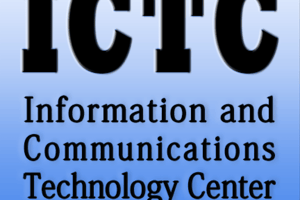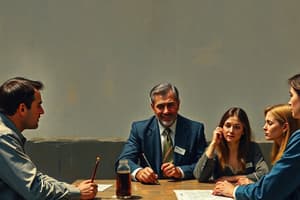Podcast
Questions and Answers
What is a key factor that distinguishes effective leaders in the corporate world?
What is a key factor that distinguishes effective leaders in the corporate world?
- Their proficiency in drafting persuasive communications (correct)
- Their promotional strategies
- Their ability to manage budgets effectively
- Their technical skills in software applications
How does effective writing impact employee morale and job satisfaction?
How does effective writing impact employee morale and job satisfaction?
- It fosters transparent communication and a positive atmosphere (correct)
- It replaces the need for verbal communication
- It increases competition among team members
- It allows employees to work independently without guidance
What writing style is most appropriate for formal reports and business documents?
What writing style is most appropriate for formal reports and business documents?
- Conversational and informal
- Casual and humorous
- Clear, precise, and professional (correct)
- Creative and expressive
In which form can written communication foster a culture of continuous learning?
In which form can written communication foster a culture of continuous learning?
What role does tone of voice play in written communication?
What role does tone of voice play in written communication?
What type of tone is generally appropriate for internal communications among team members?
What type of tone is generally appropriate for internal communications among team members?
Leaders who adapt their writing style to context and audience showcase what quality?
Leaders who adapt their writing style to context and audience showcase what quality?
Which of the following is NOT a benefit of effective written communication in the workplace?
Which of the following is NOT a benefit of effective written communication in the workplace?
What role does a warm tone of voice play in communication?
What role does a warm tone of voice play in communication?
Which of the following indicates defensiveness in body language?
Which of the following indicates defensiveness in body language?
How does body language influence communication?
How does body language influence communication?
What does an upright posture in communication usually convey?
What does an upright posture in communication usually convey?
What effect does a broad, authentic smile have in communication?
What effect does a broad, authentic smile have in communication?
Which facial expression typically indicates fear?
Which facial expression typically indicates fear?
What aspect of communication does paralinguistics refer to?
What aspect of communication does paralinguistics refer to?
Which body language signal indicates a desire to exit a conversation?
Which body language signal indicates a desire to exit a conversation?
What is the primary function of written communication in the workplace?
What is the primary function of written communication in the workplace?
Which of the following statements best reflects the importance of written communication within a team?
Which of the following statements best reflects the importance of written communication within a team?
What challenge does written communication help overcome in remote work environments?
What challenge does written communication help overcome in remote work environments?
How does effective written communication contribute to professional success?
How does effective written communication contribute to professional success?
Which statement about written communication in the business world is accurate?
Which statement about written communication in the business world is accurate?
In the context of team collaboration, which skill is emphasized as beneficial?
In the context of team collaboration, which skill is emphasized as beneficial?
Why is written communication particularly significant in the context of distributed teams?
Why is written communication particularly significant in the context of distributed teams?
What type of business documentation is NOT typically associated with written communication?
What type of business documentation is NOT typically associated with written communication?
What does a higher pitched voice typically indicate?
What does a higher pitched voice typically indicate?
Which tone would likely convey aggression or urgency?
Which tone would likely convey aggression or urgency?
In the context of interpersonal spaces, what is the typical distance for social interactions?
In the context of interpersonal spaces, what is the typical distance for social interactions?
What nonverbal cue does a firm handshake support?
What nonverbal cue does a firm handshake support?
What does sustained direct eye contact usually convey?
What does sustained direct eye contact usually convey?
Which of the following artifacts may indicate wealth and status?
Which of the following artifacts may indicate wealth and status?
What is the interpersonal space called when standing 0-1 feet apart?
What is the interpersonal space called when standing 0-1 feet apart?
What type of touch typically conveys direction and care?
What type of touch typically conveys direction and care?
What does avoiding eye contact typically indicate?
What does avoiding eye contact typically indicate?
What message does long silence usually convey in a conversation?
What message does long silence usually convey in a conversation?
How does brief eye contact typically function during a conversation?
How does brief eye contact typically function during a conversation?
Which of the following is a physiological attribute that provides nonverbal cues?
Which of the following is a physiological attribute that provides nonverbal cues?
What is the first step in improving nonverbal communication skills?
What is the first step in improving nonverbal communication skills?
What does practicing an upright posture during interactions signal?
What does practicing an upright posture during interactions signal?
How do overweight individuals often face social judgments?
How do overweight individuals often face social judgments?
What effect does recording oneself during conversations have on self-awareness?
What effect does recording oneself during conversations have on self-awareness?
Flashcards are hidden until you start studying
Study Notes
Effective Workplace Communication
- Effective communication in the workplace comprises both verbal and written forms, each with advantages.
- Verbal communication allows for quick interaction and nuanced expression through tone and body language.
- Written communication provides a lasting record and a structured way to convey information.
- Different communication forms are suited to various situations.
- Face-to-face interactions are beneficial for team building and addressing complex issues.
- Written communication is crucial for documenting decisions, sharing important information, and ensuring clarity.
The Impact of Effective Written Communication on Team Dynamics
- Effective communication is crucial for team cohesion, collaboration, and understanding.
- Written communication is particularly important for remote teams, where face-to-face interactions are limited.
- Tools like email, instant messaging, and collaborative platforms keep remote teams connected and informed.
- Clear writing skills minimize misinterpretations and misunderstandings.
- Effective email writing, well-structured documents, and persuasive communication contribute to project success.
Importance of Written Communication in Business Situations
- Clear and accurate communication is essential in the business world.
- Effective written communication is crucial for drafting persuasive emails, crafting compelling reports, and communicating decisions with clarity.
- Strong writing skills are a hallmark of effective business leaders.
The Impact of Effective Writing on Employee Morale and Satisfaction
- Transparent communication and effective writing contribute to higher employee morale and job satisfaction.
- When information is shared openly and employees feel heard and understood, a positive and collaborative atmosphere is created.
- Clear communication of expectations, goals, and feedback through written channels keeps employees well-informed and aligned with organizational objectives.
The Use of Written Communication in Different Forms
- Different written communication forms are tailored to various contexts and purposes in the workplace.
- Formal reports and business documents require a clear, precise, and professional writing style.
- Internal communications and team updates may use a more conversational tone to foster camaraderie.
- Blogs and digital content are increasingly used for conveying information within organizations.
- Engaging and informative blog posts contribute to internal knowledge sharing and a culture of continuous learning.
- Digital content also serves as a tool for external communication, enabling organizations to share insights and updates with a wider audience.
The Importance of Tone and Style in Written Communication
- Tone of voice and writing style significantly impact the effectiveness of written communication.
- A professional tone is crucial in formal documents, business letters, and external stakeholder communications.
- The ability to strike the right tone ensures messages are received as intended, fosters positive relationships, and facilitates mutual understanding.
- In internal communications and team interactions, a more relaxed and conversational tone may be appropriate.
- The tone used in written communication influences the overall workplace culture and how employees perceive the organization and their colleagues.
- Leaders who can adapt their writing style to the context and audience demonstrate emotional intelligence and adaptability.
Nonverbal Communication
- Nonverbal communication involves using body language, facial expressions, vocal cues, proxemics, and other behaviors to convey messages without words.
- It plays a vital role in building relationships, expressing emotions, and conveying meaning.
- By improving nonverbal communication skills, individuals can express themselves more genuinely, manage interactions smoothly, build trust, connect with others, and avoid misinterpretations.
Types of Nonverbal Communication
- Body language includes communicating through facial expressions, posture, gestures, and limb positioning.
- Facial expressions, like smiles, frowns, surprise, disgust, fear, and eye contact, convey emotions.
- Paralinguistics refers to vocal cues such as pitch, tone, inflection, speed, volume, and laughter.
- Proxemics involves using interpersonal space to convey attitudes and relationships.
- Artifacts include nonverbal cues chosen and displayed, such as clothing, hairstyles, accessories, makeup, and scent.
- Haptics refers to nonverbal communication through touch, including handshakes, pats, guiding, hugging, and high fives.
- Eye contact patterns, like direct eye contact, breaking eye contact, short glances, staring, and avoiding eye contact, provide nonverbal signals.
- Silence has significant nonverbal meaning, including pauses, reflection, disapproval, defensiveness, and confusion.
- Physical attributes like attractiveness, height, weight, muscular build, and gender trigger unconscious assumptions about individuals.
Improving Nonverbal Communication Skills
- Increase self-awareness: Be conscious of your own nonverbal cues by recording yourself in conversations and analyzing your body language, tone, and other signals.
- Adjustment of nonverbals consciously: Once aware of your natural tendencies, adjust them to align with the desired impression.
- Improve bodily cues: Use confident postures, limit fidgeting, employ strategic hand motions, and relax your facial expressions.
- Consciously adjust signals based on context and audience.
- Practice to master skills and improve confidence.
Studying That Suits You
Use AI to generate personalized quizzes and flashcards to suit your learning preferences.




